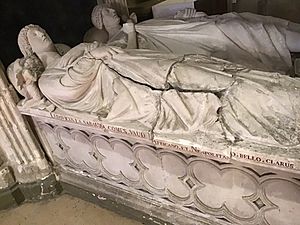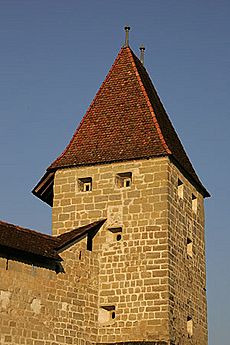Louis I of Vaud facts for kids
Louis I (born around 1249 or 1250, died 1302) was an important leader known as the Baron of Vaud. He started as a younger son in the powerful House of Savoy. However, through some unexpected events and his own skill in battle, he managed to create his own special area, almost like a small kingdom, in a region called the pays de Vaud by 1286.
Louis traveled a lot and met many important people, including kings and queens in England, France, and Naples. He even got permission from the Holy Roman Emperor to make his own coins. He also held the first public meeting in Piedmont that included people who were not nobles. When Louis I passed away, his son inherited his barony.
Contents
Early Life and Travels (1259–1281)
Louis was the third son of Thomas II of Savoy. When his father died in 1259, Louis was cared for by his mother, Beatrice dei Fieschi. His older brothers were held hostage at the time. Louis spent his childhood in his mother's castles, especially one called Saint-Genix-d'Aoste.
In 1270, when he was a teenager, Louis went to England with his brothers, Thomas III and Amadeus V. They hoped to receive lands and money that their uncle, Peter II, Count of Savoy, had left them. Some of these lands had already been given to King Henry III's son, Prince Edward Longshanks. Since Prince Edward was away on a Crusade, the claims could not be settled right away. Instead, King Henry gave each brother an annual payment of one hundred marks.
While Louis was living in Paris in July 1281, the French King Philip III of France asked him to join an alliance. This group supported the Angevin family against certain bishops. Louis likely joined because he was promised marriage to Jeanne de Montfort. She was a wealthy widow. Their marriage probably happened in 1283. Jeanne's dowry (money or property brought by a bride) included lands in Bugey and Valromey. These lands were important because they were in an area where Savoy was trying to expand.
Battles and Challenges (1281–1284)
In late 1282, Louis returned to help his family, led by Count Philip of Savoy. A war had started with Amadeus II of Geneva and his allies. Louis captured a fortress called La Buissière. He then moved into the Grésivaudan region, while his brother Amadeus attacked south of Grenoble.
Count Philip seemed to be preparing Louis to take charge of the pays de Vaud. As early as September 1281, Louis was sent to Moudon. This was an early Savoyard town in the Vaud region. His task was to receive the homage (a pledge of loyalty) from some of the count's vassals.
Louis might have felt that his efforts were not fully appreciated. In January 1283, Margaret of Provence, the Queen Mother of France, tried to help settle disagreements between Louis, his brother, and his uncle. However, her efforts did not succeed.
In the spring of 1283, Rudolf, the King of Germany, tried to strengthen his power in Helvetia. This meant he was moving into areas that Savoy controlled. Rudolf first attacked Payerne in the Vaud region in June, but his attack was stopped. Louis then arrived in the city with troops to help defend it. Rudolf then surrounded the city for six months. Eventually, the people inside ran out of food, and the city had to surrender in December. Savoy lost Payerne.
After peace was made with the King of Germany, Savoy lost Payerne and Gümmenen. They also lost control over Morat and Bern. These losses greatly reduced the power of the Savoyard prince who would rule the Vaud. However, the peace treaty allowed Moudon and the important castle of Romont to remain under the Count of Savoy. Only the lands that Peter II had gained before he became count were left for Louis. This seemed to cause another disagreement for Louis. In March 1284, Louis and Amadeus met in Lyon. They swore not to make any secret alliances to gain more land. If their uncle Count Philip or Queen Margaret could not help them agree, they promised to accept the decision of Duke Robert.
A New Beginning as Baron (1284–1286)
In 1282, Louis's oldest brother, Thomas, died. In 1283, his mother also passed away. This created a problem about who would rule next. The current Count of Savoy, Philip, had no sons. Thomas's sons were too young to rule. So, Amadeus was recognized as Philip's heir.
Louis was promised a special share of land and income, but he felt it was not enough. Some old writers said Louis fought his brother for more land. However, it is more likely that Louis felt he had not been rewarded enough for his hard work in the wars between 1282 and 1284.
In May 1284, Louis received permission from Rudolf to make coins in the pays de Vaud. This was an important sign that the Emperor recognized Louis's leadership there. In October, Count Philip asked Queen Eleanor of Provence and her son, King Edward, to help settle Louis's complaints. Philip also sent a bishop to England to explain the situation. Philip's will stated that Queen Eleanor and King Edward should decide the matter.
After Philip died, Louis did briefly fight his brother. But Louis and Amadeus reached an agreement in January 1286. In exchange for Louis promising loyalty, he received the entire pays de Vaud. This area was located between the Aubonne and Veveyse rivers. It included Moudon and Romont. He also received Saillon and Conthey in Valais, and Pierre-Châtel in Bugey. Plus, he received an annual payment from the tolls of Saint-Maurice-d'Agaune and Villeneuve. A few lords in the pays de Vaud remained loyal to the Count of Savoy, and their lands were not part of Louis's barony.
Louis I: Baron of Vaud (1286–1302)
As Baron, Louis I divided the pays de Vaud into ten main areas, each with a castle. These areas included Nyon, Rolle, Morges, Moudon, Estavayer, Romont, Rue, Yverdon, Les Clées, and Vaulruz. Morges became the main capital of the barony. This is where people pledged their loyalty and where the government was managed.
On January 15, 1285, Louis sent an important message from Lyon. He called for everyone in the Piedmont region to attend a special meeting on May 24. This was the first meeting in the Savoyard lands that included "representatives of the non-noble classes." Louis invited "all noblemen, citizens, burgesses and others with them in the land of Piedmont." This was a big step because it gave more people a voice.
Louis's oldest son, Louis II, took over as Baron of Vaud after his father. Louis I's daughter, Blanche, made a good marriage to a nephew of Otho de Grandison. This marriage was arranged in May 1303 in Paris. Blanche's sons later served the Count of Savoy.
Louis I died in Naples in 1302.
Images for kids





